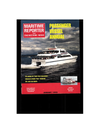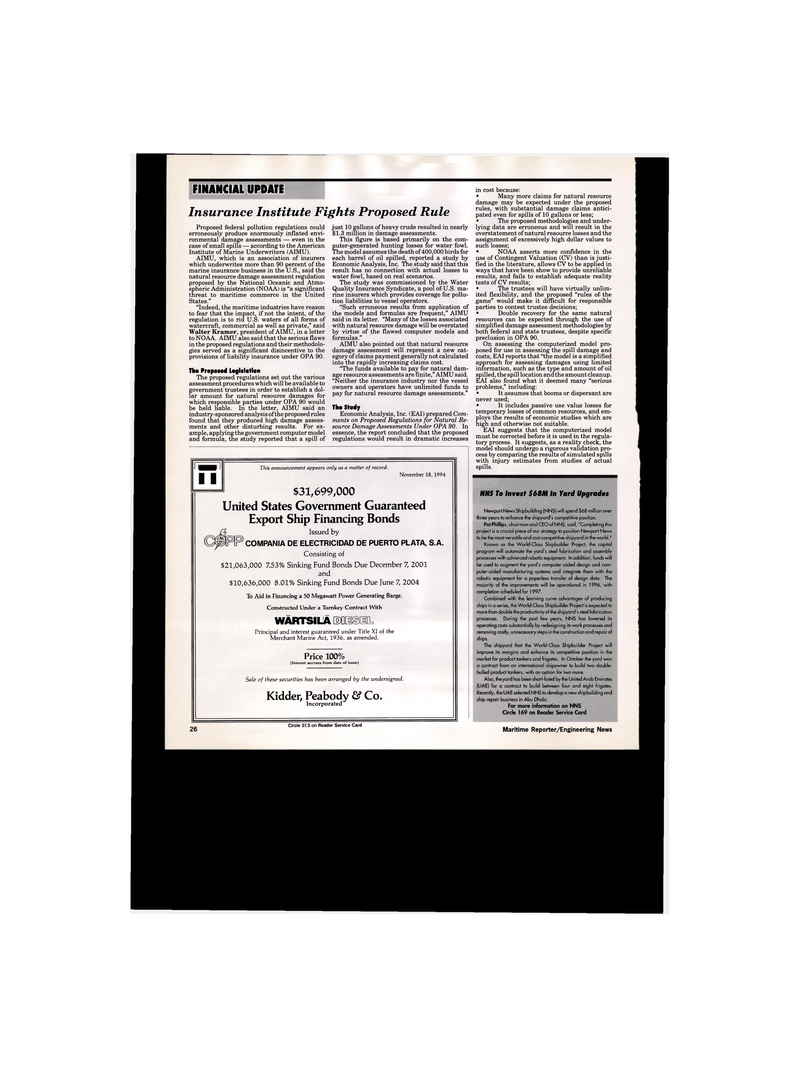
Page 24: of Maritime Reporter Magazine (January 1995)
Read this page in Pdf, Flash or Html5 edition of January 1995 Maritime Reporter Magazine
FINANCIAL UPDATE
Insurance Institute Fights Proposed Rule
Proposed federal pollution regulations could erroneously produce enormously inflated envi- ronmental damage assessments — even in the case of small spills — according to the American
Institute of Marine Underwriters (AIMU).
AIMU, which is an association of insurers which underwrites more than 90 percent of the marine insurance business in the U.S., said the natural resource damage assessment regulation proposed by the National Oceanic and Atmo- spheric Administration (NOAA) is "a significant threat to maritime commerce in the United
States." "Indeed, the maritime industries have reason to fear that the impact, if not the intent, of the regulation is to rid U.S. waters of all forms of watercraft, commercial as well as private," said
Walter Kramer, president of AIMU, in a letter to NOAA. AIMU also said that the serious flaws in the proposed regulations and their methodolo- gies served as a significant disincentive to the provisions of liability insurance under OPA 90.
The Proposed Legislation
The proposed regulations set out the various assessment procedures which will be available to government trustees in order to establish a dol- lar amount for natural resource damages for which responsible parties under OPA 90 would be held liable. In the letter, AIMU said an industry-sponsored analysis of the proposed rules found that they produced high damage assess- ments and other disturbing results. For ex- ample, applying the government computer model and formula, the study reported that a spill of just 10 gallons of heavy crude resulted in nearly $1.3 million in damage assessments.
This figure is based primarily on the com- puter-generated hunting losses for water fowl.
The model assumes the death of400,000 birds for each barrel of oil spilled, reported a study by
Economic Analysis, Inc. The study said that this result has no connection with actual losses to water fowl, based on real scenarios.
The study was commissioned by the Water
Quality Insurance Syndicate, a pool of U.S. ma- rine insurers which provides coverage for pollu- tion liabilities to vessel operators. "Such erroneous results from application of the models and formulas are frequent," AIMU said in its letter. "Many of the losses associated with natural resource damage will be overstated by virtue of the flawed computer models and formulas."
AIMU also pointed out that natural resource damage assessment will represent a new cat- egory of claims payment generally not calculated into the rapidly increasing claims cost. "The funds available to pay for natural dam- age resource assessments are finite," AIMU said. "Neither the insurance industry nor the vessel owners and operators have unlimited funds to pay for natural resource damage assessments."
The Study
Economic Analysis, Inc. (EAI) prepared Com- ments on Proposed Regulations for Natural Re- source Damage Assessments Under OPA 90. In essence, the report concluded that the proposed regulations would result in dramatic increases in cost because: • Many more claims for natural resource damage may be expected under the proposed rules, with substantial damage claims antici- pated even for spills of 10 gallons or less; • The proposed methodologies and under- lying data are erroneous and will result in the overstatement of natural resource losses and the assignment of excessively high dollar values to such losses; • NOAA asserts more confidence in the use of Contingent Valuation (CV) than is justi- fied in the literature, allows CV to be applied in ways that have been show to provide unreliable results, and fails to establish adequate reality tests of CV results; • The trustees will have virtually unlim- ited flexibility, and the proposed "rules of the game" would make it difficult for responsible parties to contest trustee decisions; • Double recovery for the same natural resources can be expected through the use of simplified damage assessment methodologies by both federal and state trustees, despite specific preclusion in OPA 90.
On assessing the computerized model pro- posed for use in assessing the spill damage and costs, EAI reports that "the model is a simplified approach for assessing damages using limited information, such as the type and amount of oil spilled, the spill location and the amount cleanup.
EAI also found what it deemed many "serious problems," including: • It assumes that booms or dispersant are never used; • It includes passive use value losses for temporary losses of common resources, and em- ploys the results of economic studies which are high and otherwise not suitable.
EAI suggests that the computerized model must be corrected before it is used in the regula- tory process. It suggests, as a reality check, the model should undergo a rigorous validation pro- cess by comparing the results of simulated spills with injury estimates from studies of actual spills. m This announcement appears only as a matter of record.
November 18,1994 $31,699,000
United States Government Guaranteed
Export Ship Financing Bonds
Issued by
COMPANIA DE ELECTRICIDAD DE PUERTO PLATA, S.A.
Consisting of $21,063,000 7.53% Sinking Fund Bonds Due December 7, 2001 and $10,636,000 8.01% Sinking Fund Bonds Due June 7, 2004
To Aid in Financing a 50 Megawatt Power Generating Barge.
Constructed Under a Turnkey Contract With
WARTSILA Mi
Principal and interest guaranteed under Title XI of the
Merchant Marine Act, 1936, as amended.
Price 100% (Interest accrues from date of issue)
Sale of these securities has been arranged by the undersigned.
Kidder, Peabody & Co.
Incorporated
NNS To Invest $68M In Yard Upgrades
Newport News Shipbuilding (NNS) will spend $68 million over three years to enhance the shipyard's competitive position.
Pat Phillips, chairman and CEO of NNS, said, "Completing this project is a crucial piece of our strategy to position Newport News to be the most versatile and cost competitive shipyard in the world."
Known as the World-Class Shipbuilder Project, the capital program will automate the yard's steel fabrication and assembly processes with advanced robotic equipment. In addition, funds will be used to augment the yard's computer-aided design and com- puter-aided manufacturing systems and integrate them with the robotic equipment for a paperless transfer of design data. The majority of the improvements will be operational in 1996, with completion scheduled for 1997.
Combined with the learning curve advantages of producing ships in a series, the World-Class Shipbuilder Project is expected to more than double the productivity of the shipyard's steel fabrication processes. During the past few years, NNS has lowered its operating costs substantially by redesigning its work processes and removing costly, unnecessary steps in the construction and repair of ships.
The shipyard that the World-Class Shipbuilder Project will improve its margins and enhance its competitive position in the market for product tankers and frigates. In October the yard won a contract from an international shipowner to build two double- hulled product tankers, with an option for two more.
Also, the yard has been short-listed by the United Arab Emirates (UAE) for a contract to build between four and eight frigates.
Recently, the UAE selected NNS to develop a new shipbuilding and ship repair business in Abu Dhabi.
For more information on NNS
Circle 169 on Reader Service Card 26D Circle 243 on Reader Service Card Maritime Reporter/Engineering News

 23
23

 25
25
